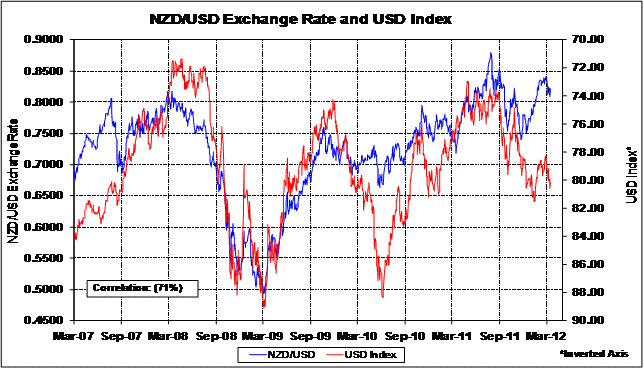
 By Roger J Kerr
By Roger J Kerr
Returning from a week’s holiday overseas and assessing the lay of the land in the interest rate markets leaves me more confused than ever:-
- The last RBNZ monetary policy statement was more on the dovish side than expected, however they increased their March 2013 GDP growth forecast.
- The RBNZ appear very comfortable with their benign inflation outlook despite growing resource pressures in the building sector, rising prices for insurance/electricity/petrol/beer/rates and the prospect of a lower NZD/USD exchange rate not providing off-setting deflation from imported consumer goods.
- Talk of increased bank borrowing margins doing some of the monetary tightening for the RBNZ in 2012, despite credit spreads for Australasian banks decreasing sharply in the derivative credit default swap market over the last six months and recent bank bond issues being swamped with investor demand i.e. bank borrowing margins are going down, not up.
- US Fed Reserve Chief Ben Bernanke and his band of dovish Governors this year still not being convinced that the stronger US economic data over the last four to five months is for real, despite Wall Street (Dow Jones Share Index) telling us the opposite.
- Local bank economists continue to debate the merits of fixing the mortgage now or later based on RBNZ OCR timing considerations. The take-out is that the banks with higher GDP forecasts (e.g. BNZ) favour fixing now, which is the camp I would be in.
Global investment markets no longer seem to have the risks they once had now that some progress is being made in Europe and as a consequence the previous safe haven buying of US Treasury Bonds is reversing. Global fixed interest fund managers who have been holding portfolio duration positions longer than benchmark will now be reversing their positions with the latest increase in US bond yields from 2.00% to 2.30% (i.e. selling bonds, forcing the yield higher).
Our long term (10-year) swap rates continue to follow the US yields and have increased sharply to 4.60% from rates below 4.00% not so long ago. Over the medium term that upwards trend in US long-term interest rates should continue.
These increases in long term rates will pull up our three and four year swap rates. The current debate between bank economists on whether home mortgage borrowers should fix now or later appears to ignore what is happening with US long term interest rates.
Whilst floating rates may stay lower for longer this year, those who wait off may will find the two and three year fixed mortgage rates 0.50% higher when they finally decide to fix.
My view remains in place, that the RBNZ will be forced to change their current complacent/benign inflation outlook markedly by September.
General USD direction suggests lower NZD/USD rate
The Kiwi dollar at 0.8250 against the US dollar sits bang in the middle of its 0.8050 to 0.8450 trading range it has established over recent months. The currency markets are not keen to buy the NZ dollar towards the top-end of the range and it has bounced off the bottom end a couple of times. Judging by past performance, the impasse and general stability of the currency is unlikely to last.
Over coming months the probability of a break out on the bottom side to below 0.8000 appears higher than the chances of NZD appreciation to the 0.8500/0.8600 level. Supporting the lower view is the fact that the US dollar itself is starting to make gains against all currencies on the back of consistently stronger US economic data and rising long term US interest rates.
US Government 10-year Treasury bond yields have over this last week broken sharply higher to 2.30% from the 2.00% level that they have remained at for the last two years. The overall US dollar currency index is pushing up towards 80.00, a level it has remained below for over 12 months as the prospect of further quantitative monetary easing by the Federal Reserve persisted (printing of USD’s, thus increasing the supply). US economic data this year, particularly stronger employment growth, suggests that the US economy is now recovering under its own steam and does not need further monetary stimulus. Fed Reserve Chief, Ben Bernanke is seemingly not totally convinced about all this (yet). However, the FX markets are voting with their feet in pushing the value of the USD upwards as they do not expect further printing of additional US dollars by the Fed.
Weaker trends in both the Euro and Japanese Yen against the USD from current levels over coming weeks suggest that the USD Index will head higher to 82 and 83. It is difficult to see the NZD/USD rate moving in the opposite direction and strengthen further against this general USD strength. As the chart below clearly shows, there is a high historical correlation between the NZD/USD rate and the USD Index. The chart also highlights the divergence earlier this year when the Kiwi appreciated from 0.7600 to 0.8400 on strong Chinese economic data unrelated to USD movements generally. There still exists a reasonable chance that the “China premium” in the NZD/USD rate will unwind as Chinese economic data slows over the next few months. The Chinese authorities are certainly expecting a slowing up of their growth, however it has not yet materialised in their official economic figures.

Combining the international forces (USD value, commodity prices, global sharemarkets and Chinese economic data) with the local NZ drivers of the Kiwi dollar (dairy prices and interest rates) still points to a lower NZD/USD rate in the short to medium term (next three to six months).
However, from a level between 0.7500 and 0.8000 later in the year the RBNZ should be more comfortable about lifting NZ interest rates to keep inflationary pressures under control. Under the alternative scenario (not expected) that the NZD/USD rate remains well above 0.8000 over the next six months, the RBNZ will hesitate from increasing interest rates later in the year as the higher currency value will automatically tighten monetary conditions, slow the economy and keep inflation in check with lower imported goods prices.
In the short term, GDP growth figures on 22 March for the December 2011 quarter and the NBNZ Business Confidence survey on 29 March will confirm that the NZ economy is expanding at a faster clip than most expected at this time. Tempering that positive economic message will be dairy prices most probably declining again in the Fonterra/GDT online auction this week.
--------------------
* Roger J Kerr runs Asia Pacific Risk Management. He specialises in fixed interest securities and is a commentator on economics and markets. More commentary and useful information on fixed interest investing can be found at rogeradvice.com

We welcome your comments below. If you are not already registered, please register to comment.
Remember we welcome robust, respectful and insightful debate. We don't welcome abusive or defamatory comments and will de-register those repeatedly making such comments. Our current comment policy is here.